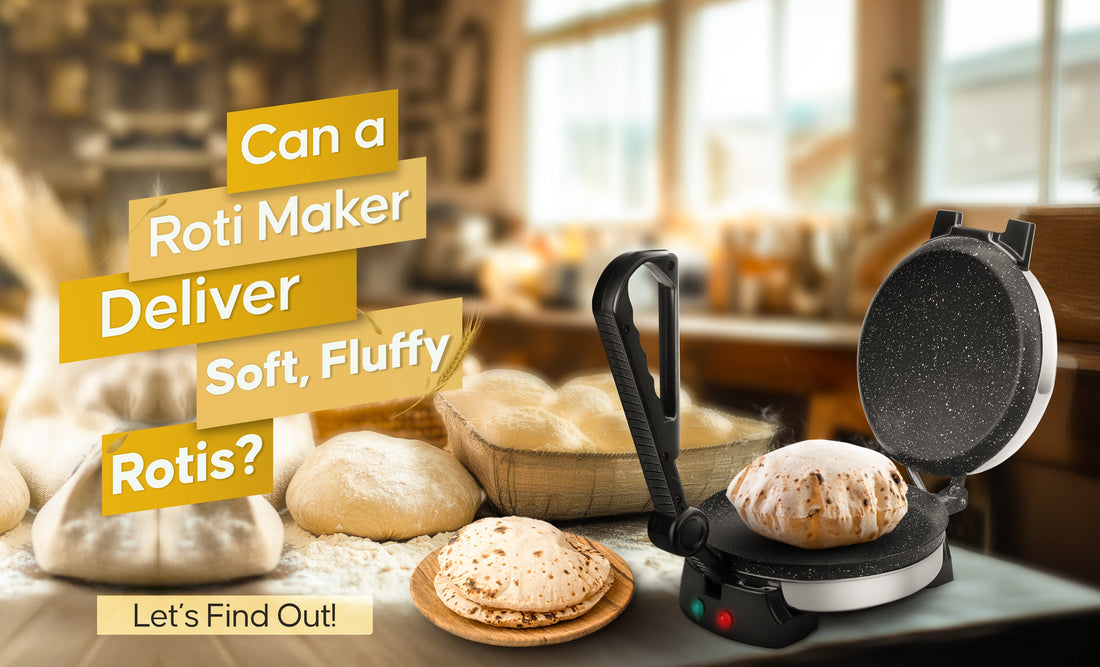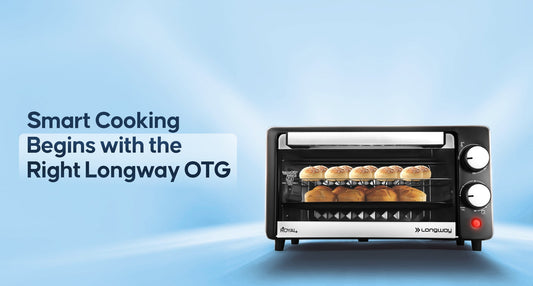Can a Roti Maker Deliver Soft, Fluffy Rotis? Let’s Find Out!

It’s a busy weekday morning, and you’re scrambling to pack lunch. The dough is ready, but rolling out round rotis while keeping an eye on the gas stove feels like a race against time. By the time you flip the first roti, the second one is burning on the edges. Sound familiar?
Or maybe you’re a student living away from home, craving homemade rotis but dreading the rolling-pin struggle. You try to make one, only for it to turn into a weirdly shaped, half-burnt disaster.
The art of making soft, fluffy rotis has been passed down through generations. From watching our grandmothers effortlessly roll out perfectly round rotis to seeing our mothers balance the right amount of heat on the tawa, there’s a certain nostalgia attached to this everyday staple. But let’s be honest, not everyone has the time or skill to master the craft.
That’s where the roti maker comes in, a modern kitchen gadget designed to simplify the process. But can it truly replicate the magic of handmade rotis? Let’s find out.
The Promise of a Roti Maker
A roti maker is designed to streamline the entire process—eliminating the need for rolling, pressing, and managing high flame temperatures. Instead of juggling between a rolling pin and a hot tawa, a roti maker aims to simplify the steps: just press, cook, and serve.
With the right roti maker, the goal is to get soft, evenly cooked, and fluffy rotis that taste just like handmade ones. But do these appliances really work as promised?
Features That Make a Roti Maker Effective
To truly evaluate if a roti maker can deliver soft and fluffy rotis, we need to look at its key features. One such product that stands out in the market is the Longway Automatic Electric Roti Maker. Here’s how it enhances the cooking experience:
a) High-Powered Heating (1000 W) for Quick Cooking
One of the most crucial aspects of making perfect rotis is temperature control. The Longway Roti Maker features a 1000 W heating element that ensures quick and even heating, reducing cooking time while maintaining optimal texture.

b) Non-Stick Stainless Steel Press
A non-stick surface is essential to prevent dough from sticking and tearing. This roti maker has a high-quality non-stick coating, ensuring smooth handling, effortless flipping, and easy cleaning.
c) Uniform Thickness & Even Cooking
The key to fluffy rotis lies in uniform thickness. This roti maker allows you to press evenly, ensuring every roti puffs up just right, achieving that soft, airy texture.
d) Multipurpose Functionality
Apart from making rotis, this appliance is also perfect for chapatis, parathas, khakras, dosa, chila, tortillas, and even paneer tikka—expanding its usability beyond just rotis.
e) Quick Heating & Safety Features
Equipped with an indicator lamp, the device signals when it’s ready to use. Additionally, heat-resistant handles and an auto shut-off feature ensure safe operation.
The Secret to Soft & Fluffy Rotis Using a Roti Maker
While a roti maker can handle the heat and pressing, the quality of rotis depends on the technique and dough preparation. Here are the expert tips to ensure your rotis turn out soft and fluffy:
Dough Consistency: Roti maker dough should be softer than traditional dough (use slightly more water while kneading).
Resting Time: Let the dough rest for 15-20 minutes before making rotis. This allows gluten to relax, making rotis softer.
Preheating the Roti Maker: Always preheat for 3-5 minutes before use for even cooking.
Pressing Technique: A gentle press and quick release will allow the dough to spread evenly without becoming too thin.
Flipping Timing: Flip at the right time—too early or too late can make the roti hard instead of fluffy.
Testing the Longway Roti Maker: Does It Deliver?
To put this to the test, we used the Longway Automatic Electric Roti Maker following the recommended techniques. Here’s what we observed:
Ease of Use: The process was quick and hassle-free, reducing manual effort.
Texture & Puffiness: The rotis came out soft, well-cooked, and puffed up evenly.
Time Efficiency: It took only 1-2 minutes per roti, making it ideal for busy schedules.
Cleanup: The non-stick surface made cleaning simple, with no residue sticking to the plates.
Final Verdict? Yes, the Longway Roti Maker delivers soft, fluffy rotis—when used correctly!
Common Mistakes & How to Avoid Them
Even with the best roti maker, achieving soft and fluffy rotis depends on proper technique and dough preparation. Many first-time users make common mistakes that affect the texture and puffiness of their rotis. Here’s a detailed breakdown of what to avoid and how to get the best results with an automatic roti maker.
1. Using Hard or Dry Dough
One of the biggest mistakes when using a roti maker machine is making the dough too hard or dry. Unlike traditional roti dough, the dough for an electric roti maker needs to be softer and slightly stickier to ensure proper puffing.
Solution:
Add a little extra water or milk while kneading the dough.
Let the dough rest for 15-20 minutes before making rotis. This allows the gluten to relax, making the rotis soft and pliable.
Always cover the dough with a damp cloth to prevent drying out.
2. Not Preheating the Roti Maker Properly
An automatic roti maker works best when it is preheated to the right temperature before placing the dough. Many users skip this step, resulting in uneven cooking and hard rotis.
Solution:
Preheat the roti maker for 3-5 minutes before use.
Most electric roti makers come with an indicator lamp—wait for it to turn green or off (depending on the model) before placing the dough.
If you notice your roti is not puffing up, chances are the plates are not hot enough.
3. Over-Pressing the Dough
Pressing the dough too hard or for too long in the roti maker machine can make rotis too thin, dry, and tough instead of soft and fluffy.
Solution:
Gently press down once or twice to spread the dough evenly.
Avoid pressing continuously, as this can remove too much moisture and affect puffing.
If the best roti maker is properly heated, the dough will automatically spread to the right thickness without excessive pressing.
4. Flipping Too Soon or Too Late
Timing is crucial when making rotis in an electric roti maker. Flipping too early can prevent proper cooking, while flipping too late can lead to overcooked or burnt rotis.
Solution:
Once you close the automatic roti maker, wait for about 30-40 seconds before flipping.
After flipping, cook for another 20-30 seconds to ensure even cooking.
If you want perfectly puffed rotis, press lightly with a spatula right before the final flip.
Conclusion
So, can a roti maker truly deliver soft, fluffy rotis? The answer is a resounding YES, provided you use the right technique and a high-quality appliance like the Longway Automatic Electric Roti Maker.
No more struggling with rolling pins, uneven cooking, or spending too much time in the kitchen. With this powerful, multipurpose, and easy-to-use roti maker, you can enjoy delicious, homemade rotis in minutes!






